Fungal Tolerance: An Alternative for the Selection of Fungi with Potential for the Biological Recovery of Precious Metals
Abstract
1. Introduction
2. Materials and Methods
2.1. Fungal Strains
2.2. Identification of Fungi
2.3. Culture of Filamentous Fungi in a Solid Medium with Au, Ag and Pt
2.4. Statistic Analysis
3. Results
3.1. Fungal Tolerance to Au
3.2. Ag Fungal Tolerance
3.3. Fungal Tolerance to Pt
4. Discussion
5. Conclusions
Author Contributions
Funding
Acknowledgments
Conflicts of Interest
References
- Balcerzack, M. Sample digestion methods for the determination of traces of precious metals by spectrophotometric techniques. Anal. Sci. 2002, 18, 737–750. [Google Scholar] [CrossRef]
- Baltzer, N.; Copponnex, T. Precious Metals of Biomedical Applications, 1st ed.; Elsevier Science: Cambridge, UK, 2014; 236p. [Google Scholar]
- Butler, J. Precious materials handbook. Platin. Met. Rev. 2012, 56, 267–270. [Google Scholar] [CrossRef]
- Thakor, A.S.; Jokerst, J.; Zaveleta, C.; Massoud, T.F.; Gambhi, S.S. Gold nanoparticles: A revival in precious metal administration to patients. Nano Lett. 2011, 11, 4029–4036. [Google Scholar] [CrossRef]
- Dobson, R.S.; Burgess, J.E. Biological treatment of precious metal refinery wastewater: A review. Miner. Eng. 2007, 20, 519–532. [Google Scholar] [CrossRef]
- Wang, M.; Tan, Q.; Chiang, J.F.; Li, J. Recovery of rare and precious metals from urban mines—A review. Front. Environ. Sci. Eng. 2017, 11, 1–17. [Google Scholar] [CrossRef]
- Fomina, M.; Ritz, K.; Gadd, G.M. Nutritional influence on the ability of fungal mycelia to penetrate toxic metal-containing domains. Mycol. Res. 2003, 107, 861–871. [Google Scholar] [CrossRef] [PubMed]
- Bruins, M.R.; Kapil, S.; Oehme, F.W. Microbial resistance to metals in the environment. Ecotox. Environ. Safe 2000, 45, 198–207. [Google Scholar] [CrossRef] [PubMed]
- Davis, T.A.; Volesky, B.; Mucci, A. A review of the biochemistry of heavy metal biosorption by brown algae. Water Res. 2003, 37, 4311–4330. [Google Scholar] [CrossRef]
- Ehrlich, H.L. Microbes and metals. Appl. Microbiol. Biotechnol. 1997, 48, 687–692. [Google Scholar] [CrossRef]
- Gadd, G.M. Metals, minerals, and microbes: Geomicrobiology and bioremediation. Microbiology 2010, 156, 609–643. [Google Scholar] [CrossRef]
- Liu, G.; Ling, S.; Zhan, X.; Lin, Z.; Zhang, W.; Lin, K. Interaction effects and mechanism of Pb pollution and soil microorganism in the presence of earthworm. Chemosphere 2017, 173, 227–234. [Google Scholar] [CrossRef] [PubMed]
- Roane, T.M.; Pepper, L.L.; Gentry, T.L. Microorganisms and metal pollutants. In Environmental Microbiology, 3rd ed.; Pepper, L.L., Gerba, C.P., Gentry, T.J., Eds.; Academic Press: Salt Lake City, UT, USA, 2014; pp. 415–439. [Google Scholar]
- Sterritt, R.M.; Lester, J.N. Interactions of heavy metals with bacteria. Sci. Total Environ. 1980, 14, 5–17. [Google Scholar] [CrossRef]
- Xue, H.; Stumm, W.; Sigg, L. The binding of heavy metals to algal surfaces. Water Res. 1988, 22, 917–926. [Google Scholar] [CrossRef]
- Kaksonen, A.H.; Mudunuru, B.M.; Hackl, R. The role of microorganisms in gold processing a recovery: A review. Hydrometallurgy 2014, 142, 70–83. [Google Scholar] [CrossRef]
- Li, M.; Tian, H.; Wang, L.; Duan, J. Bacterial diversity in linglong gold mine, China. Geomicrobiol. J. 2017, 34, 267–273. [Google Scholar] [CrossRef]
- Reith, F.; Lengke, M.F.; Falconer, D.; Craw, D.; Southam, G. The geomicrobiology of gold. ISME J. 2007, 1, 567–584. [Google Scholar] [CrossRef]
- Sanyal, S.K.; Shuster, J.; Reith, F. Cycling of biogenic elements drives biogeochemical gold cycling. Earth Sci. Rev. 2019, 190, 131–147. [Google Scholar] [CrossRef]
- Shuster, J.; Southam, G. The in-vitro “growth” of gold grains. Geology 2015, 43, 79–82. [Google Scholar] [CrossRef]
- Devasia, P.; Natarajan, K.A. Bacterial leaching: Biotechnology in the mining Industry. Resonance 2004, 9, 27–34. [Google Scholar] [CrossRef]
- Gonzalez, R.; Gentina, J.C.; Acevedo, F. Biooxidation of a gold concentrate in a continuous stirred tank reactor: Mathematical model and optimal configuration. Biochem. Eng. J. 2004, 19, 33–42. [Google Scholar] [CrossRef]
- Kaksonen, A.H.; Perrot, F.; Morris, C.; Rea, S.; Benvie, B.; Austin, P.; Hackl, R. Evaluation of submerged bio-oxidation concept for refractory gold ores. Hydrometallurgy 2014, 141, 117–125. [Google Scholar] [CrossRef]
- Mubarok, M.Z.; Winarko, R.; Chaerun, S.K.; Rizki, I.N.; Ichlas, Z.T. Improving gold recovery from refractory gold ores through biooxidation using iron-sulfur-oxidizing/sulfur-oxidizing mixotrophic bacteria. Hydrometallurgy 2017, 168, 69–75. [Google Scholar] [CrossRef]
- Muravyov, M. Two-step processing of refractory gold-containing sulfidic concentrate via biooxidation at two temperatures. Chem. Pap. 2019, 73, 173–183. [Google Scholar] [CrossRef]
- Olson, G.J. Microbial oxidation of gold ores and gold bioleaching. FEMS Microbiol. Lett. 1994, 119, 1–6. [Google Scholar] [CrossRef][Green Version]
- Rawlings, D.E.; Silver, S. Mining with microbes. Nat. Biotechnol. 1995, 13, 773–778. [Google Scholar] [CrossRef]
- Schippers, A.; Hedrich, S.; Vasters, J.; Drobe, M.; Sand, W.; Willscher, S. Biomining: Metal Recovery from Ores with Microorganisms. In Geobiotechnology I. Advances in Biochemical Engineering/Biotechnology; Schippers, A., Glombitza, F., Sand, W., Eds.; Springer: Berlin/Heidelberg, Germany, 2013; Volume 41, pp. 1–47. [Google Scholar]
- Alshehri, A.N.Z. Microbial recovery of gold metal from untreated and pretreated electronic wastes by wild and mutated cyanogenic Bacillus megaterium. Am. J. Microbiol. Res. 2018, 6, 14–21. [Google Scholar]
- Arshadi, M.; Mousavi, S.M. Enhancement of simultaneous gold and copper extraction from computer printed circuit boards using Bacillus megaterium. Bioresour. Technol. 2015, 175, 315–324. [Google Scholar] [CrossRef]
- Brandl, H.; Lehmann, S.; Faramarzi, M.A.; Martinelli, D. Biomobilization of silver, gold, and platinum from solid waste materials by HCN-forming microorganisms. Hydrometallurgy 2008, 94, 14–17. [Google Scholar] [CrossRef]
- Argumedo-Delira, R.; Díaz-Martínez, M.E.; Gómez-Martínez, M.J. Microorganisms and plants in the recovery of metals from the printed circuit boards of computers and cell phones: A mini review. Metals 2020, 10, 1120. [Google Scholar] [CrossRef]
- Kumar, A.; Saini, H.S.; Kumar, S. Bioleaching of gold and silver from waste printed circuit boards by Pseudomonas balearica SAE1 isolated from an e-waste recycling facility. Curr. Microbiol. 2018, 75, 194–201. [Google Scholar] [CrossRef]
- Natarajan, G.; Ting, Y.-P. Pretreatment of e-waste and mutation of alkali-tolerant cyanogenic bacteria promote gold biorecovery. Bioresour. Technol. 2014, 152, 80–85. [Google Scholar] [CrossRef] [PubMed]
- Tay, S.B.; Natarajan, G.; Rahim, M.N.B.A.; Tan, H.T.; Chung, M.C.M.; Ting, Y.P.; Yew, W.S. Enhancing gold recovery from electronic waste via lixiviant metabolic engineering in Chromobacterium violaceum. Sci. Rep. 2013, 3, 1–7. [Google Scholar] [CrossRef] [PubMed]
- Argumedo-Delira, R.; Gómez-Martínez, M.J.; Soto, B.J. Gold bioleaching from printed circuit boards of mobile phones by Aspergillus niger in a culture without agitation and with glucose as a carbon source. Metals 2019, 9, 521. [Google Scholar] [CrossRef]
- Bindschedler, S.; Vu Bouquet, T.Q.T.; Job, D. Fungal biorecovery of gold from e-waste. Adv. Appl. Microbiol. 2017, 99, 53–81. [Google Scholar]
- Madrigal-Arias, J.E.; Argumedo-Delira, R.; Alarcón, A.; Mendoza-López, M.R.; García-Barradas, O.; Cruz-Sánchez, J.S.; Ferrera-Cerrato, R.; Jiménez-Fernández, M. Bioleaching of gold, copper and nickel from waste cellular phone PCBs and computer goldfinger motherboards by two Aspergillus niger strains. Braz. J. Microbiol. 2015, 46, 707–713. [Google Scholar] [CrossRef]
- Drake, P.L.; Hazelwood, K.J. Exposure-related health effects of silver and silver compounds: A review. Ann. Occup. Hyg. 2005, 49, 575–585. [Google Scholar]
- Goddard, P.A.; Bull, A.T. The isolation and characterisation of bacteria capable of accumulating silver. Appl. Microbiol. Biotechnol. 1989, 31, 308–313. [Google Scholar] [CrossRef]
- Pareek, V.; Gupta, R.; Panwar, J. Do physico-chemical properties of silver nanoparticles decide their interaction with biological media and bactericidal action? A review. Mater. Sci. Eng. C. 2018, 90, 739–749. [Google Scholar] [CrossRef]
- Slawson, R.M.; Lee, H.; Trevors, J.T. Bacterial interactions with silver. Biol. Metals 1990, 3, 151–154. [Google Scholar] [CrossRef]
- Pooley, F.D. Bacteria accumulate silver during leaching of sulphide ore minerals. Nature 1982, 296, 642–643. [Google Scholar] [CrossRef]
- Murthy, D.S.R. Microbially enhanced thiourea leaching of gold and silver from lead-zinc sulphide flotation tailings. Hydrometallurgy 1990, 25, 51–60. [Google Scholar] [CrossRef]
- Rusin, P.; Cassells, J.; Sharp, J.; Arnold, R.; Sinclair, N.A. Bioprocessing of refractory oxide ores by bioreduction: Extraction of silver, molybdenum, and copper. Miner. Eng. 1992, 5, 1345–1354. [Google Scholar] [CrossRef]
- Zhappar, N.K.; Shaikhutdinov, V.M.; Kanafin, Y.N.; Ten, O.A.; Balpanov, D.S.; Korolkov, I.V.; Collinson, S.R.; Erkasov, R.S.; Bakibaev, A.A. Bacterial and chemical leaching of copper-containing ores with the possibility of subsequent recovery of trace silver. Chem. Pap. 2019, 73, 1357–1367. [Google Scholar] [CrossRef]
- Maes, S.; Props, R.; Fitts, J.P.; Smet, R.D.; Vilchez-Vargas, R.; Vital, M.; Pieper, D.H.; Vanhaecke, F.; Boon, N.; Hennebel, T. Platinum recovery from synthetic extreme environments by halophilic bacteria. Environ. Sci. Technol. 2016, 50, 2619–2626. [Google Scholar] [CrossRef]
- Madrigal-Arias, J.E. Biolixiviación de Metales Utilizando Bacterias y Hongos a Partir de Desechos Electrónicos. Licentiate Thesis, Universidad Veracruzana, Xalapa, Mexico, 13 December 2012. [Google Scholar]
- Wilson, K.H.; Blitchington, R.B.; Greene, R.C. Amplification of bacterial 16S ribosomal DNA with polymerase chain reaction. J. Clin. Microbiol. 1990, 28, 1942–1946. [Google Scholar] [CrossRef]
- Sambrook, J.; Rusell, D.W. Molecular Cloning: A Laboratory Manual, 3rd ed.; Cold Spring Harbor Laboratory Press: New York, NY, USA, 2001; 800p. [Google Scholar]
- SAS. Institute Inc. The SAS System for Windows, Version 9.4; SAS Institute Inc.: Cary, NC, USA, 2018. [Google Scholar]
- Baldrian, P.; Gabriel, J. Effect of heavy metals on the growth of selected wood-rotting basidiomycetes. Folia Microbiol. 1997, 42, 521–523. [Google Scholar] [CrossRef]
- Baldrian, P. Interactions of heavy metals with white-rot fungi. Enzyme Microb. Technol. 2003, 32, 78–91. [Google Scholar] [CrossRef]
- Guillén, Y.; Machuca, Á. The effect of copper on the growth of wood-rotting fungi and a blue-stain fungus. World J. Microb. Biot. 2008, 24, 31–37. [Google Scholar] [CrossRef]
- Kowshik, M.; Nazareth, S. Metal tolerance of Fusarium solani. Ecol. Environ. Conserv. 2000, 6, 391–395. [Google Scholar]
- Nazareth, S.; Marbaniang, T. Effect of heavy metals on cultural and morphological growth characteristics of halotolerant Penicillium morphotypes. J. Basic Microbiol. 2008, 48, 363–369. [Google Scholar] [CrossRef]
- Biryuzova, V.I.; Korobushkina, E.D.; Pozmogova, I.N.; Karavaiko, G.I. Accumulation of gold by cell Candida utilis. Mikrobiologiya 1987, 56, 155–161. [Google Scholar]
- Karamushka, V.I.; Gadd, G.M. Interaction of Saccharomyces cerevisiae with gold: Toxicity and accumulation. BioMetals 1999, 12, 289–294. [Google Scholar] [CrossRef]
- Novelli, F.; Recine, M.; Sparatore, F.; Juliano, C. Gold (I) complexes as antimicrobial agents. Farmaco 1999, 54, 232–236. [Google Scholar] [CrossRef]
- Martínez-Aldino, I.Y. Estudio de la Respuesta Fisiológica de Fusarium Oxysporum MX17 y Fusarium Solani MXPE15 al Cultivarse en Medios con AuCl3. Licentiate Thesis, Universidad Veracruzana, Xalapa, Mexico, 7 January 2016. [Google Scholar]
- Díaz-Martínez, M.E.; Argumedo-Delira, R.; Sánchez-Viveros, G.; Alarcón, A.; Mendoza-López, M.R. Microbial bioleaching of Ag, Au and Cu from printed circuit boards of mobile phone. Curr. Microbiol. 2019, 76, 536–544. [Google Scholar] [CrossRef] [PubMed]
- Piimpel, T.; Schinner, F. Silver tolerance and silver accumulation of microorganisms from soil materials of a silver mine. Appl. Microbiol. Biotechnol. 1986, 24, 244–247. [Google Scholar] [CrossRef]
- Díaz-Martínez, M.E. Plantas y Microorganismos Útiles en la Recuperación de Metales Provenientes de Residuos Electrónicos. Ph.D. Thesis, Universidad Veracruzana, Xalapa Veracruz, México, February 2019. [Google Scholar]
- LeRoy, A.F. Interactions of platinum metals and their complexes in biological systems. Environ. Health Perspect. 1975, 10, 73–78. [Google Scholar] [CrossRef] [PubMed]
- Rosenberg, B.; Renshaw, E.; Vancamp, L.; Hartwick, J.; Drobnik, J. Platinum-induced filamentous growth in Escherichia coli. J. Bacteriol. Res. 1967, 93, 716–721. [Google Scholar] [CrossRef] [PubMed]
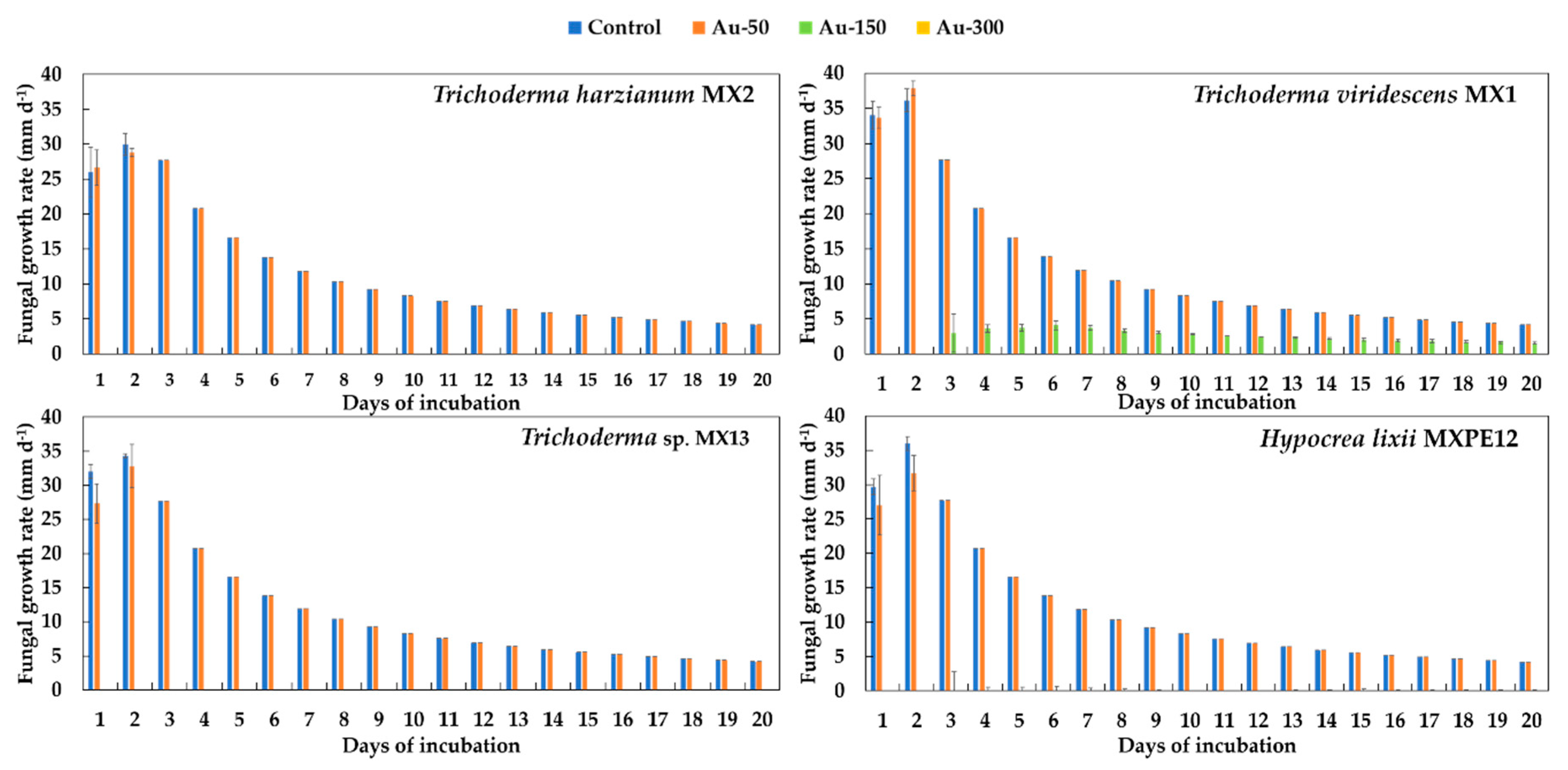

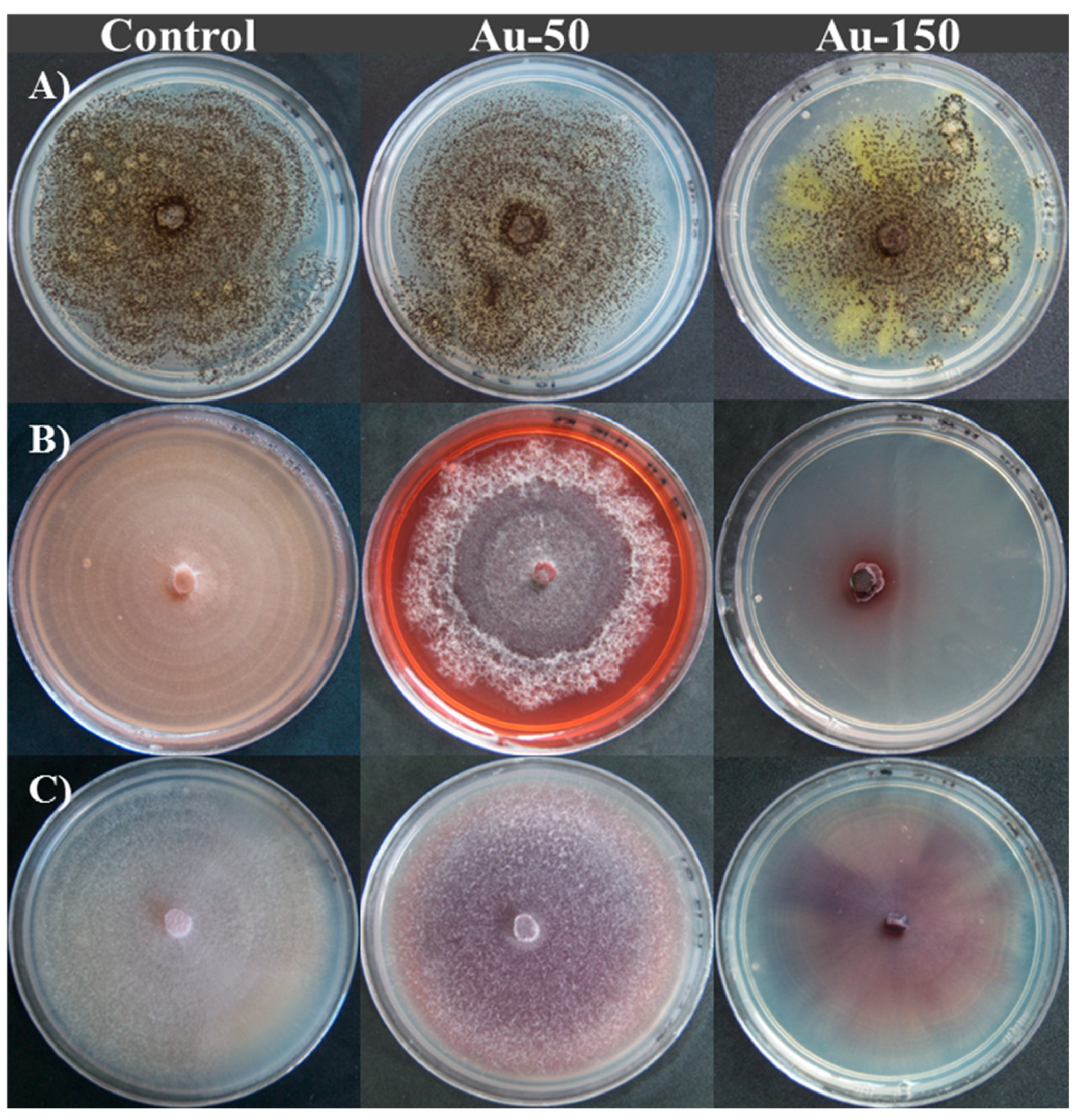

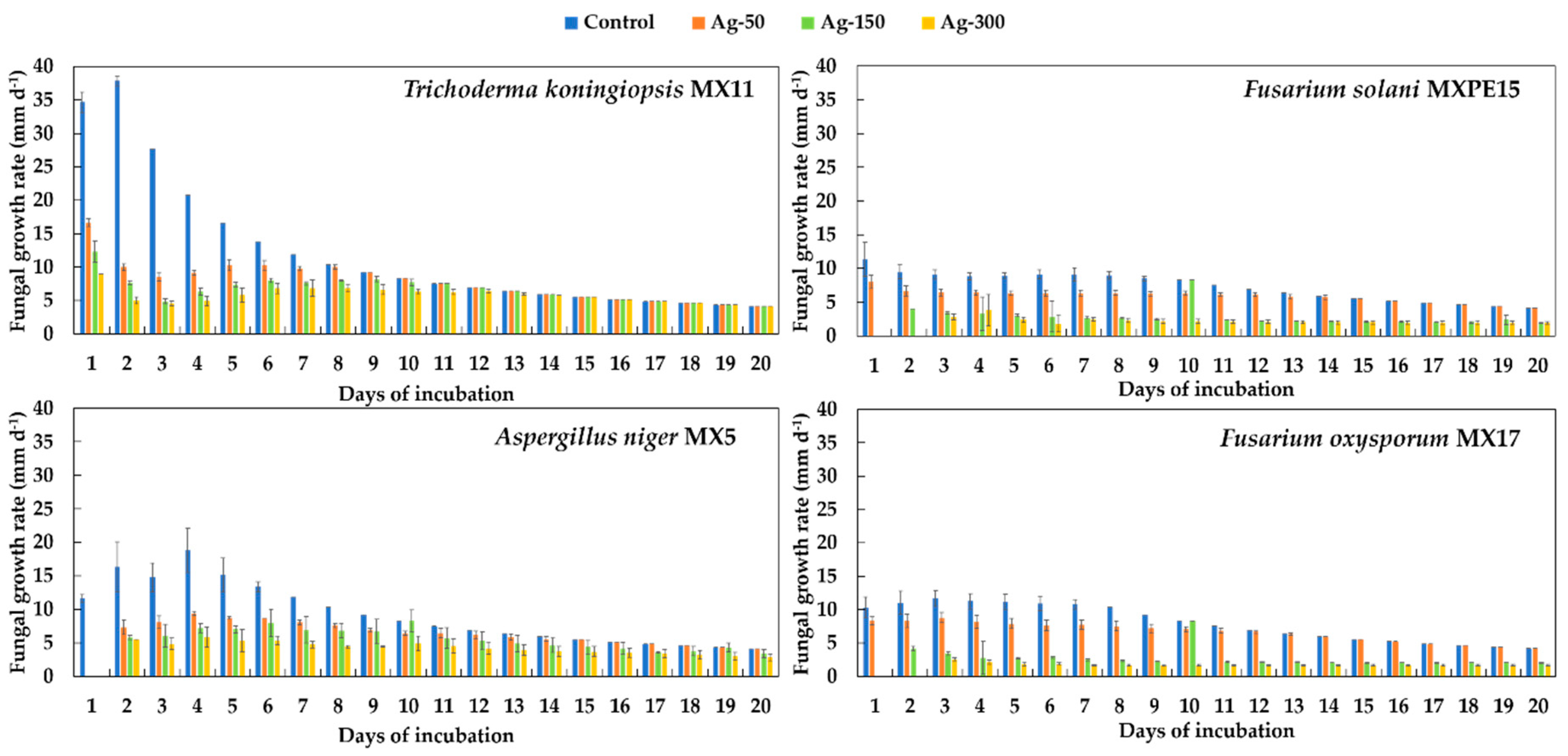


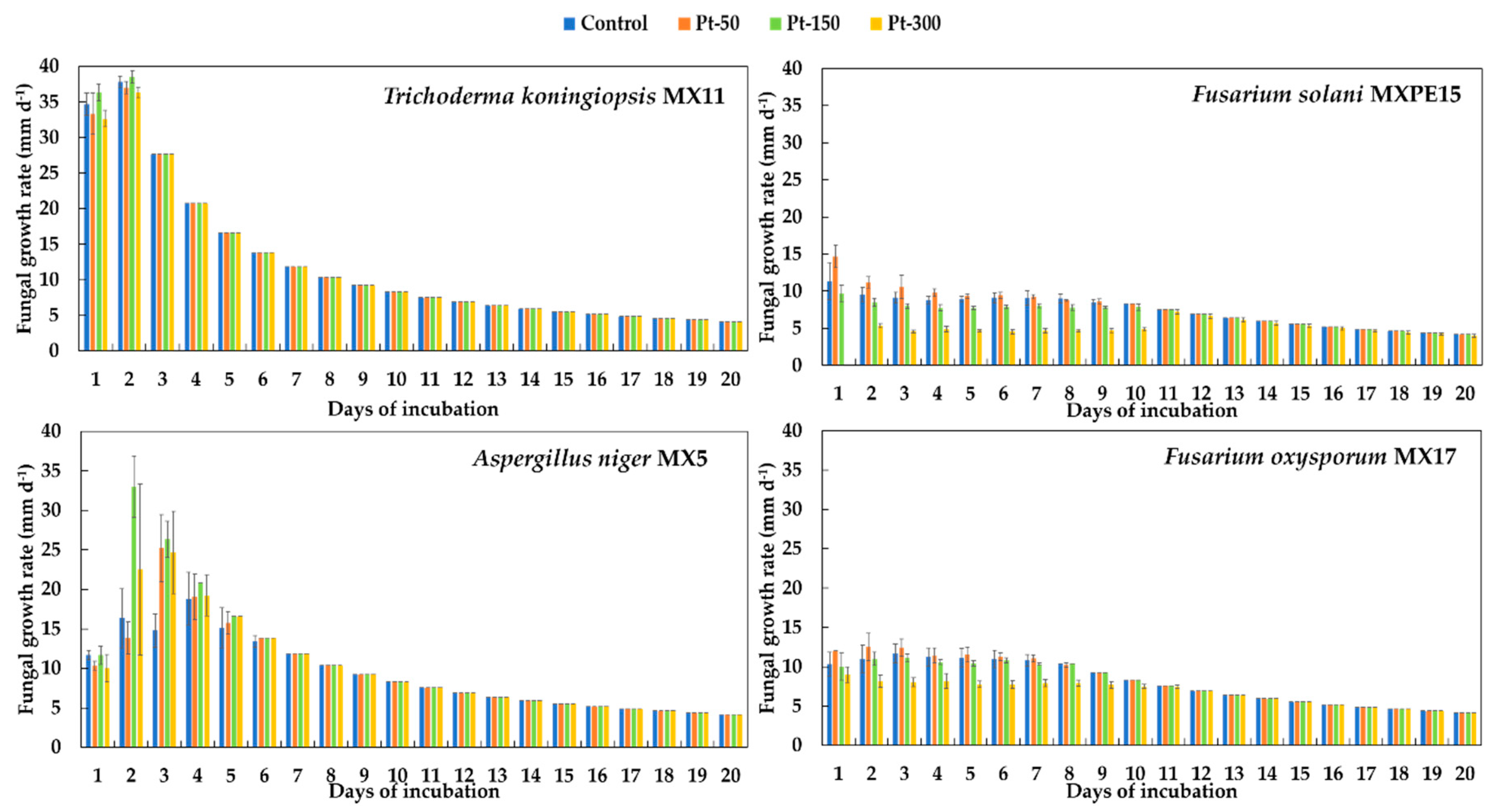
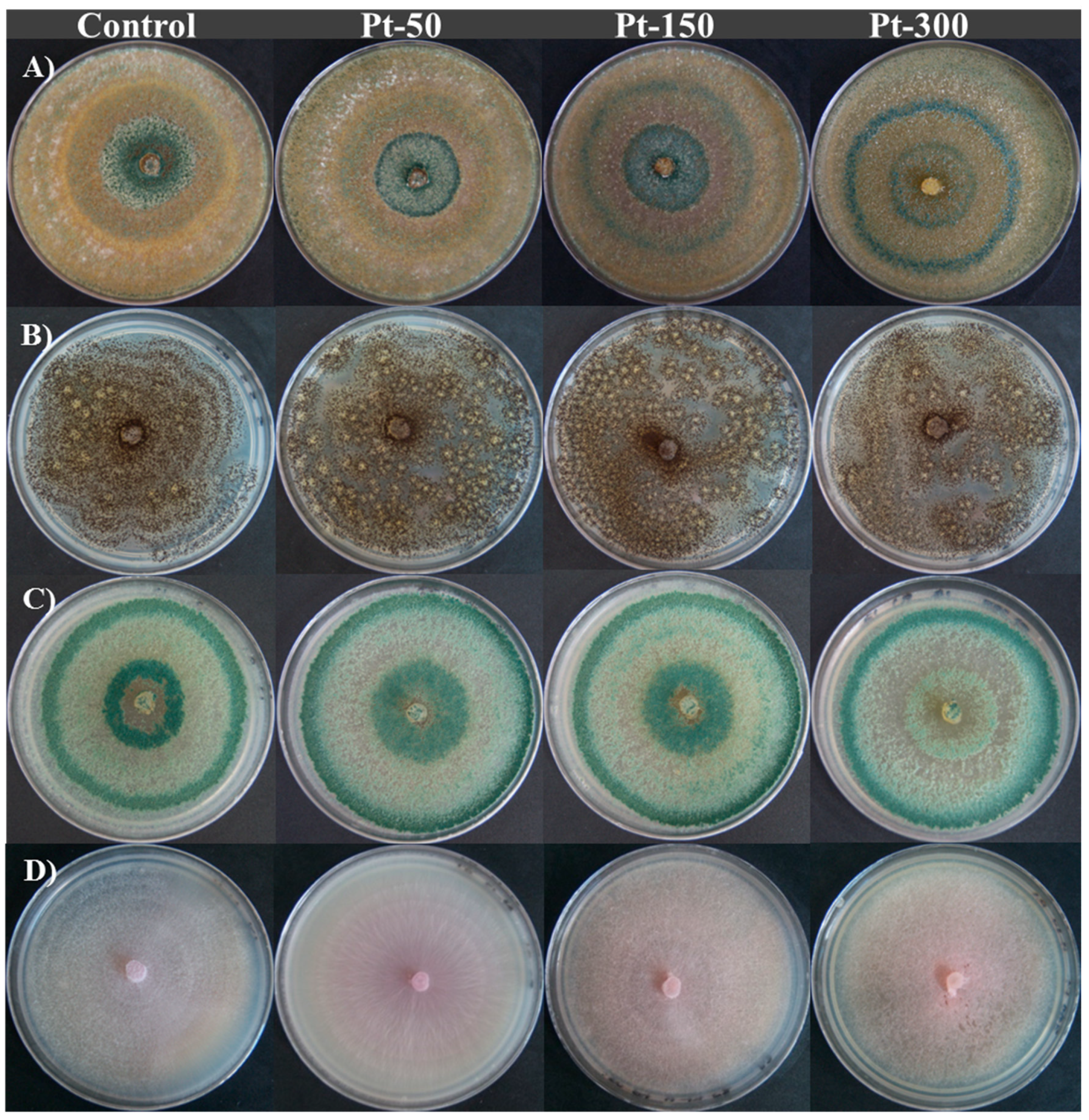
Publisher’s Note: MDPI stays neutral with regard to jurisdictional claims in published maps and institutional affiliations. |
© 2020 by the authors. Licensee MDPI, Basel, Switzerland. This article is an open access article distributed under the terms and conditions of the Creative Commons Attribution (CC BY) license (http://creativecommons.org/licenses/by/4.0/).
Share and Cite
Argumedo-Delira, R.; Gómez-Martínez, M.J.; Uribe-Kaffure, R. Fungal Tolerance: An Alternative for the Selection of Fungi with Potential for the Biological Recovery of Precious Metals. Appl. Sci. 2020, 10, 8096. https://doi.org/10.3390/app10228096
Argumedo-Delira R, Gómez-Martínez MJ, Uribe-Kaffure R. Fungal Tolerance: An Alternative for the Selection of Fungi with Potential for the Biological Recovery of Precious Metals. Applied Sciences. 2020; 10(22):8096. https://doi.org/10.3390/app10228096
Chicago/Turabian StyleArgumedo-Delira, Rosalba, Mario J. Gómez-Martínez, and Ramiro Uribe-Kaffure. 2020. "Fungal Tolerance: An Alternative for the Selection of Fungi with Potential for the Biological Recovery of Precious Metals" Applied Sciences 10, no. 22: 8096. https://doi.org/10.3390/app10228096
APA StyleArgumedo-Delira, R., Gómez-Martínez, M. J., & Uribe-Kaffure, R. (2020). Fungal Tolerance: An Alternative for the Selection of Fungi with Potential for the Biological Recovery of Precious Metals. Applied Sciences, 10(22), 8096. https://doi.org/10.3390/app10228096




